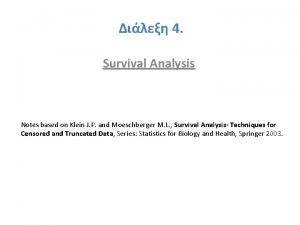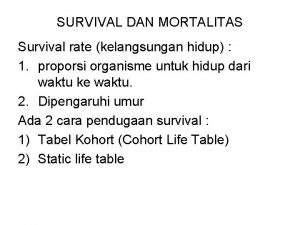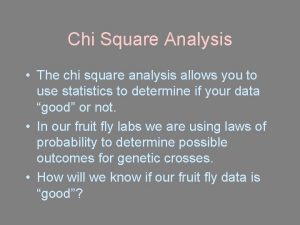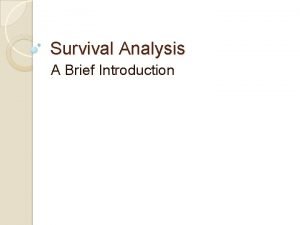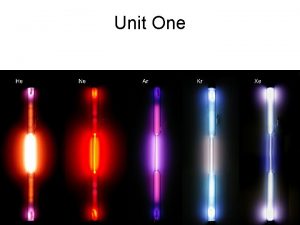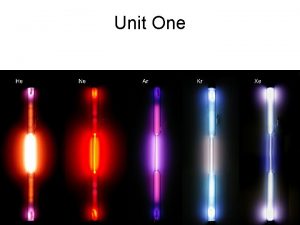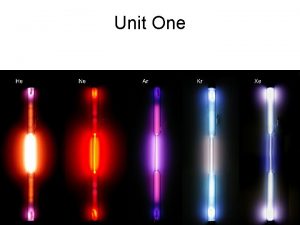Survival Analysis From Square One to Square Two






























- Slides: 30

Survival Analysis: From Square One to Square Two Yin Bun Cheung, Ph. D. Paul Yip, Ph. D. Readings

Lecture structure • Basic concepts • Kaplan-Meier analysis • Cox regression • Computer practice

What’s in a name? • time-to-event data • failure-time data • censored data (unobserved outcome)

Types of censoring – loss to follow-up during the study period – study closure

Examples of survival analysis 1. Marital status & mortality 2. Medical treatments & tumor recurrence & mortality in cancer patients 3. Size at birth & developmental milestones in infants

Why survival analysis ? • Censoring (time of event not observed) • Unequal follow-up time

What is time? What is the origin of time? In epidemiology: • Age (birth as time 0) ? • Calendar time since a baseline survey ?

What is the origin of time? In clinical trials: • Since randomisation ? • Since treatment begins ? • Since onset of exposure ?

The choice of origin of time • Onset of continuous exposure • Randomisation to treatment • Strongest effect on the hazard

Types of survival analysis 1. Non-parametric method Kaplan-Meier analysis 2. Semi-parametric method Cox regression 3. Parametric method

Square 1 to square 2 This lecture focuses on two commonly used methods • Kaplan-Meier method • Cox regression model

KM survival curve * d=death, c=censored, surv=survival

KM survival curve

No. of expected deaths Expected death in group A at time i, assuming equality in survival: EAi =no. at risk in group A i death i total no. at risk i Total expected death in group A: EA = EAi

Log rank test • A comparison of the number of expected and observed deaths. • The larger the discrepancy, the less plausible the null hypothesis of equality.

An approximation The log rank test statistic is often approximated by X 2 = (OA-EA)2/EA+ (OB-EB)2/EB, where OA & EA are the observed & expected number of deaths in group A, etc.

1 1 . 8 . 6 S(t) Proportional hazard assumption . 4 . 2 0 0 0 5 10 Time 15 20 Log rank test preferred (PH true ) 0 5 10 Time 15 20 Breslow test preferred (non-PH)

Risk, conditional risk, hazard

Hazard Another look of PH 0 5 10 15 20 Time Log rank test Breslow test preferred (PH true ) preferred (non-PH)

Cox regression model • Handles 1 exposure variables. • Covariate effects given as Hazard Ratios. • Semi-parametric: only assumes proportional hazard.

Cox model in the case of a single variable 1. hi(t) = h. B(t) exp(BXi) 2. hj(t) = h. B(t) exp(BXj) 3. hi(t)/hj(t) =exp[B(Xi-Xj)] exp(B) is a Hazard Ratio

Test of proportional hazard assumption • Scaled Schoenfeld residuals • Grambsch-Therneau test • Test for treatment period interaction • Example: mortality of widows

Computer practice A clinical trial of stage I bladder tumor Thiotepa vs Control Data from Stat. Lib

Data structure Two most important variables: • Time to recurrence (>0) • Indicator of failure/censoring (0=censored; 1=recurrence) (coding depends on software)

KM estimates Thiotepa Control

Log rank test chi 2(1) = 1. 52 Pr>chi 2 = 0. 22

Cox regression models

Test of PH assumption Grambsch-Therneau test for PH in model II • Thiotepa P=0. 55 • Number of tumor P=0. 60

Major References (Examples) Ex 1. Cheung. Int J Epidemiol 2000; 29: 93 -99. Ex 2. Sauerbrei et al. J Clin Oncol 2000; 18: 94 -101. Ex 3. Cheung et al. Int J Epidemiol 2001; 30: 66 -74.

Major References (General) • Allison. Survival Analysis using the SAS® System. • Collett. Modelling Survival Data in Medical Research. • Fisher, van Belle. Biostatistics: A Methodology for the Health Sciences.
 State of survival survival of the fittest tweak
State of survival survival of the fittest tweak State of survival survival of the fittest stages
State of survival survival of the fittest stages Structure of twelfth night
Structure of twelfth night Survival analysis vs logistic regression
Survival analysis vs logistic regression Partitioned survival analysis
Partitioned survival analysis Random censoring
Random censoring Survival analysis part ii
Survival analysis part ii One god one empire one emperor
One god one empire one emperor One one one little puppy run
One one one little puppy run One king one law one faith
One king one law one faith Byzantine definition
Byzantine definition One ford behaviors
One ford behaviors See one do one teach one
See one do one teach one One price policy
One price policy See one do one teach one
See one do one teach one One vision one identity one community
One vision one identity one community Asean one vision one identity one community
Asean one vision one identity one community One baby and two mothers story
One baby and two mothers story Othello setting act 1
Othello setting act 1 Survival vs self expression
Survival vs self expression Bobcat adaptations
Bobcat adaptations Size up the situation
Size up the situation Kata kata survive
Kata kata survive Survival skills for advocates
Survival skills for advocates Survival prioriteiten
Survival prioriteiten Survival mindset active shooter
Survival mindset active shooter Rumus kelangsungan hidup ikan
Rumus kelangsungan hidup ikan Saddle thrombus cat
Saddle thrombus cat Survival trees python
Survival trees python What is the selective pressure
What is the selective pressure Survival vs self expression
Survival vs self expression





